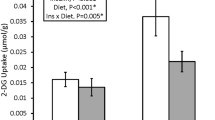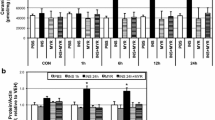Abstract
The heart is an insulin-responsive organ, and disorders of insulin action, such as diabetes and obesity, can have profound effects on cardiac performance. Insulin signaling influences numerous functions within the heart, such as metabolic substrate preference, cell size, and the response of the heart to ischemia and hypertrophy. Because the systemic consequences of altered insulin action can have significant but indirect effects on the heart, the generation of mice with altered expression of insulin receptors and key components of the insulin-signal transduction pathways in cardiomyocytes have led to interesting and occasionally surprising new insights into the regulation of cardiac biology by insulin.
Similar content being viewed by others
References and Recommended Reading
Belke DD, Betuing S, Tuttle MJ, et al.: Insulin signaling coordinately regulates cardiac size, metabolism, and contractile protein isoform expression. J Clin Invest 2002, 109:629–639. In this article, the initial description of the phenotype of CIRKO mice was presented, namely: reduced cardiac size, persistent fetal myosin isoform expression, and reduced rates of glucose and fatty acid metabolism.
Campbell FM, Kozak R, Wagner A, et al.: A role for peroxisome proliferator-activated receptor alpha (PPARalpha) in the control of cardiac malonyl-CoA levels: reduced fatty acid oxidation rates and increased glucose oxidation rates in the hearts of mice lacking PPARalpha are associated with higher concentrations of malonyl-CoA and reduced expression of malonyl-CoA decarboxylase. J Biol Chem 2002, 277:4098–4103.
Taegtmeyer H, McNulty P, Young ME: Adaptation and maladaptation of the heart in diabetes: Part I: general concepts. Circulation 2002, 105:1727–1733.
Finck BN, Lehman JJ, Leone TC, et al.: The cardiac phenotype induced by PPARalpha overexpression mimics that caused by diabetes mellitus. J Clin Invest 2002, 109:121–130. The cardiac phenotype of transgenic overexpression of PPARá in the heart is presented.
Abel ED: Glucose transport in the heart. Front Biosci 2004, 9:201–215.
Gao F, Gao E, Yue TL, et al.: Nitric oxide mediates the antiapoptotic effect of insulin in myocardial ischemia-reperfusion: the roles of PI3-kinase, Akt, and endothelial nitric oxide synthase phosphorylation. Circulation 2002, 105:1497–1502. This article shows that the cardioprotective effect of insulin in reperfused hearts following ischemia is mediated in part by PI3 kinase/Akt phosphorylation of endothelial nitric oxide synthetase.
Jonassen AK, Sack MN, Mjos OD, Yellon DM: Myocardial protection by insulin at reperfusion requires early administration and is mediated via Akt and p70s6 kinase cell-survival signaling. Circ Res 2001, 89:1191–1198.
Crozier SJ, Anthony JC, Schworer CM, et al.: Tissue-specific regulation of protein synthesis by insulin and free fatty acids. Am J Physiol Endocrinol Metab 2003, 285:E754-E762.
Saltiel AR, Pessin JE: Insulin signaling in microdomains of the plasma membrane. Traffic 2003, 4:711–716.
JeBailey L, Rudich A, Huang X, et al.: Skeletal muscle cells and adipocytes differ in their reliance on TC10 and Rac for insulin-induced actin remodeling. Mol Endocrinol 2004, 18:359–372.
Shiojima I, Yefremashvili M, Luo Z, et al.: Akt signaling mediates postnatal heart growth in response to insulin and nutritional status. J Biol Chem 2002, 277:37670–37677. This article demonstrates that the reduced cardiac size in CIRKO occurs because Akt activation fails to occur during a critical window of peak cardiac growth.
Belke DD, Larsen TS, Gibbs EM, Severson DL: Altered metabolism causes cardiac dysfunction in perfused hearts from diabetic (db/db) mice. Am J Physiol Endocrinol Metab 2000, 279:E1104-E1113.
Mazumder PK, O’Neill BT, Roberts MW, et al.: Impaired cardiac efficiency and increased fatty acid oxidation in insulin resistant ob/ob mouse hearts. Diabetes 2004, 53:2366–2374.
Wu P, Sato J, Zhao Y, et al.: Starvation and diabetes increase the amount of pyruvate dehydrogenase kinase isoenzyme 4 in rat heart. Biochem J 1998, 329:197–201.
Boudina S, O’Neill BT, Belke DD, et al.: Insulin resistance leads to progressive mitochondrial dysfunction in the mouse heart. Circulation 2003, 108 (Suppl):iv-1404.
Mazumder PK, Tuttle MJ, Accili D, Abel ED: Insulin signaling regulates cardiac substrate metabolism via cross talk between non-myocytes and cardiomyocytes. Circulation 2003, 108(Suppl):iv-1411.
Depre C, Young ME, Ying J, et al.: Streptozotocin-induced changes in cardiac gene expression in the absence of severe contractile dysfunction. J Mol Cell Cardiol 2000, 32:985–996.
Hu P, Zhang D, Swenson L, et al.: Minimally invasive aortic banding in mice: effects of altered cardiomyocyte insulin signaling during pressure overload. Am J Physiol Heart Circ Physiol 2003, 285:H1261-H1269. This manuscript demonstrated that CIRKO hearts developed functional deterioration and increased injury following pressure overload hypertrophy.
Swenson L, Zhang D, Hu P, et al.: Protective role of insulin in isoproterenol-induced cardiac injury. Circulation 2002, 106(Suppl):ii-307.
Hu P, Zhang D, Avelar E, et al.: Insulin resistance in the heart increases the mortality and contractile dysfunction after myocardial infarction. Circulation 2003, 108(Suppl):iv-894.
Shioi T, Kang PM, Douglas PS, et al.: The conserved phosphoinositide 3-kinase pathway determines heart size in mice. Embo J 2000, 19:2537–2548. This manuscript demonstrated the important role of signaling via PI3 kinase in the regulation of cardiomyocyte size.
McMullen JR, Shioi T, Zhang L, et al.: Phosphoinositide 3- kinase(p110alpha) plays a critical role for the induction of physiological, but not pathological, cardiac hypertrophy. Proc Natl Acad Sci U S A 2003, 100:12355–12360. This manuscript presented data to support a role for PI3 kinase signaling in the regulation of physiologic cardiac hypertrophy. It also demonstrated that an intact PI3 kinase signaling pathway was required for the maintenance of cardiac function and myocyte viability following pressure overload hypertrophy.
Shioi T, McMullen JR, Kang PM, et al.: Akt/protein kinase B promotes organ growth in transgenic mice. Mol Cell Biol 2002, 22:2799–2809. These studies demonstrated that the effect of PI3 kinase on cardiac growth was mediated via Akt signaling. This paper also showed that cardiac hypertrophy could be induced by overexpression of a constitutively active Akt transgene.
Chen WS, Xu PZ, Gottlob K, et al.: Growth retardation and increased apoptosis in mice with homozygous disruption of the Akt1 gene. Genes Dev 2001, 15:2203–2208.
Peng XD, Xu PZ, Chen ML, et al.: Dwarfism, impaired skin development, skeletal muscle atrophy, delayed bone development, and impeded adipogenesis in mice lacking Akt1 and Akt2. Genes Dev 2003, 17:1352–1365.
Cho H, Thorvaldsen JL, Chu Q, et al.: Akt1/PKBalpha is required for normal growth but dispensable for maintenance of glucose homeostasis in mice. J Biol Chem 2001, 276:38349–38352.
Cho H, Mu J, Kim JK, et al.: Insulin resistance and a diabetes mellitus-like syndrome in mice lacking the protein kinase Akt2 (PKB beta). Science 2001, 292:1728–1731.
Mora A, Davies AM, Bertrand L, et al.: Deficiency of PDK1 in cardiac muscle results in heart failure and increased sensitivity to hypoxia. EMBO J 2003, 22:4666–4676. This article describes the consequence of muscle-specific deletion of PDK1 expression—that is, cardiac failure, ventricular atrophy, and increased susceptibility to hypoxia.
Crackower MA, Oudit GY, Kozieradzki I, et al.: Regulation of myocardial contractility and cell size by distinct PI3K-PTEN signaling pathways. Cell 2002, 110:737–749. This paper demonstrates that inactivation of PTEN leads to increased activation of PI3 kinase activity in the heart. PI3Ká activation was responsible for cardiac hypertrophy, and PI3Kã activation lead to reduced cardiac contractility.
Condorelli G, Drusco A, Stassi G, et al.: Akt induces enhanced myocardial contractility and cell size in vivo in transgenic mice. Proc Natl Acad Sci U S A 2002, 99:12333–12338.
Kim YK, Kim SJ, Yatani A, et al.: Mechanism of enhanced cardiac function in mice with hypertrophy induced by overexpressed Akt. J Biol Chem 2003, 278:47622–47628.
Cook SA, Matsui T, Li L, Rosenzweig A: Transcriptional effects of chronic Akt activation in the heart. J Biol Chem 2002, 277:22528–22533.
Matsui T, Li L, Wu JC, et al.: Phenotypic spectrum caused by transgenic overexpression of activated Akt in the heart. J Biol Chem 2002, 277:22896–22901. This article describes the phenotypic spectrum of Akt activation in the myocardium, ranging from compensated hypertrophy to heart failure.
Ren J, Samson WK, Sowers JR: Insulin-like growth factor I as a cardiac hormone: physiological and pathophysiological implications in heart disease. J Mol Cell Cardiol 1999, 31:2049–2061.
Yamashita K, Kajstura J, Discher DJ, et al.: Reperfusion-activated Akt kinase prevents apoptosis in transgenic mouse hearts overexpressing insulin-like growth factor-1. Circ Res 2001, 88:609–614.
McMullen JR, Shioi T, Huang WY, et al.: The insulin-like growth factor 1 receptor induces physiological heart growth via the phosphoinositide 3-kinase(p110alpha) pathway. J Biol Chem 2004, 279:4782–4793.
Cohen AW, Park DS, Woodman SE, et al.: Caveolin-1 null mice develop cardiac hypertrophy with hyperactivation of p42/44 MAP kinase in cardiac fibroblasts. Am J Physiol Cell Physiol 2003, 284:C457-C474.
Woodman SE, Park DS, Cohen AW, et al.: Caveolin-3 knockout mice develop a progressive cardiomyopathy and show hyperactivation of the p42/44 MAPK cascade. J Biol Chem 2002, 277:38988–38997.
Park DS, Woodman SE, Schubert W, et al.: Caveolin-1/3 doubleknockout mice are viable, but lack both muscle and nonmuscle caveolae, and develop a severe cardiomyopathic phenotype. Am J Pathol 2002, 160:2207–2217.
Cohen AW, Razani B, Wang XB, et al.: Caveolin-1-deficient mice show insulin resistance and defective insulin receptor protein expression in adipose tissue. Am J Physiol Cell Physiol 2003, 285:C222-C235.
Katz EB, Stenbit AE, Hatton K, et al.: Cardiac and adipose tissue abnormalities but not diabetes in mice deficient in GLUT4. Nature 1995, 377:151–155.
Stenbit AE, Katz EB, Chatham JC, et al.: Preservation of glucose metabolism in hypertrophic GLUT4-null hearts. Am J Physiol Heart Circ Physiol 2000, 279:H313-H318.
Weiss RG, Chatham JC, Georgakopolous D, et al.: An increase in the myocardial PCr/ATP ratio in GLUT4 null mice. FASEB J 2002, 16:613–615. This paper describes the unusual bioenergetic profile of hearts from GLUT4 null mice—that is, increased creatine and phosphocreatine content.
Abel ED, Kaulbach HC, Tian R, et al.: Cardiac hypertrophy with preserved contractile function after selective deletion of GLUT4 from the heart. J Clin Invest 1999, 104:1703–1714. Cardiomyocyte-restricted deletion of GLUT4 induced cardiac hypertrophy is demonstrated. Cardiac contractile performance was preserved.
Tian R, Abel ED: Responses of GLUT4-deficient hearts to ischemia underscore the importance of glycolysis. Circulation 2001, 103:2961–2966. Functional and bioenergetic state of cardiomyocyte-restricted GLUT4 knockout hearts and their recovery from ischemia were worse in hearts from fasted animals.
Zaha VG, Dunn DM, Weiss RB, Abel ED: Transcriptional profiling reveals mechanisms responsible for the impaired contractile response of GLUT4 deficient hearts to fasting. Diabetes 2004, 53(Suppl1):A5.
Zaha VG, Tuttle MJ, Izumo S, et al.: GLUT4 deficient hearts exhibit a unique and distinct transcriptional profile. Diabetes 2003, 52(Suppl1):A283.
Abel ED, Graveleau C, Betuing S, et al.: Regulation of IRAP expression and targeting in the insulin responsive vesicle compartment of GLUT4 deficient cardiomyocytes. Mol Endocrinol 2004, 18:2491–2501. Loss of GLUT4 from the cardiomyocyte impairs the sorting of IRAP (a specific marker of GLUT4 vesicles) into the insulin-responsive GLUT4 vesicle compartment.
Keller SR, Davis AC, Clairmont KB: Mice deficient in the insulin-regulated membrane aminopeptidase show substantial decreases in glucose transporter GLUT4 levels but maintain normal glucose homeostasis. J Biol Chem 2002, 277:17677–17686.
Araki E, Lipes MA, Patti ME, et al.: Alternative pathway of insulin signalling in mice with targeted disruption of the IRS-1 gene. Nature 1994, 372:186–190.
Burks DJ, de Mora JF, Schubert M, et al.: IRS-2 pathways integrate female reproduction and energy homeostasis. Nature 2000, 407:377–382.
Chen B, Bronson RT, Klaman LD, et al.: Mice mutant for Egfr and Shp2 have defective cardiac semilunar valvulogenesis. Nat Genet 2000, 24:296–299.
Fruman DA, Mauvais-Jarvis F, Pollard DA, et al.: Hypoglycaemia, liver necrosis and perinatal death in mice lacking all isoforms of phosphoinositide 3-kinase p85 alpha. Nat Genet 2000, 26:379–382.
Clement S, Krause U, Desmedt F, et al.: The lipid phosphatase SHIP2 controls insulin sensitivity. Nature 2001, 409:92–97.
Naramura M, Kole HK, Hu RJ, Gu H: Altered thymic positive selection and intracellular signals in Cbl-deficient mice. Proc Natl Acad Sci U S A 1998, 95:15547–15552.
Author information
Authors and Affiliations
Rights and permissions
About this article
Cite this article
Abel, E.D. Insulin signaling in heart muscle: Lessons from genetically engineered mouse models. Current Science Inc 6, 416–423 (2004). https://doi.org/10.1007/s11906-004-0034-4
Issue Date:
DOI: https://doi.org/10.1007/s11906-004-0034-4




